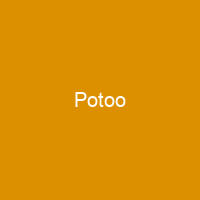Potoos are a group of Caprimulgiformes birds related to the nightjars and frogmouths. There are seven species in one genus, Nyctibius, in tropical Central and South America. Fossil remains of potoos dating from the Oligocene and Eocene have been found in France and Germany.
About Potoo in brief
 Potoos are a group of Caprimulgiformes birds related to the nightjars and frogmouths. There are seven species in one genus, Nyctibius, in tropical Central and South America. The potoos are today an exclusively New World family, but they apparently had a much more widespread distribution in the past. Fossil remains of potoos dating from the Oligocene and Eocene have been found in France and Germany. A 1996 study of the mitochondrial DNA of the potoos supported the monophyly of the family although it did not support the previous assumption that it was closely related to oilbirds. The level of divergence is the highest of any genus of birds, being more typical of the divergence between genera or even families. All species occur in humid forests, although a few species also occur in drier forests.
Potoos are a group of Caprimulgiformes birds related to the nightjars and frogmouths. There are seven species in one genus, Nyctibius, in tropical Central and South America. The potoos are today an exclusively New World family, but they apparently had a much more widespread distribution in the past. Fossil remains of potoos dating from the Oligocene and Eocene have been found in France and Germany. A 1996 study of the mitochondrial DNA of the potoos supported the monophyly of the family although it did not support the previous assumption that it was closely related to oilbirds. The level of divergence is the highest of any genus of birds, being more typical of the divergence between genera or even families. All species occur in humid forests, although a few species also occur in drier forests.
They are highly nocturnal and generally do not fly during the day. With their cryptic plumage, they spend the day perched on branches with the eyes half closed. The transition between perching and the freeze position is gradual and hardly perceptible to the observer. They have proportionally large heads for their body size and long wings and tails. The large head is dominated by a massive broad bill and enormous eyes. The eyes are large, even larger than those of night jars, and reflect the light of flashlights. Their eyes have unusual slits in the lids, which allow potoos to sense movement even when their eyes are closed. Their plumage is cryptic, helping them blend into the branches on which they spend their days.
You want to know more about Potoo?
This page is based on the article Potoo published in Wikipedia (as of Dec. 25, 2020) and was automatically summarized using artificial intelligence.







